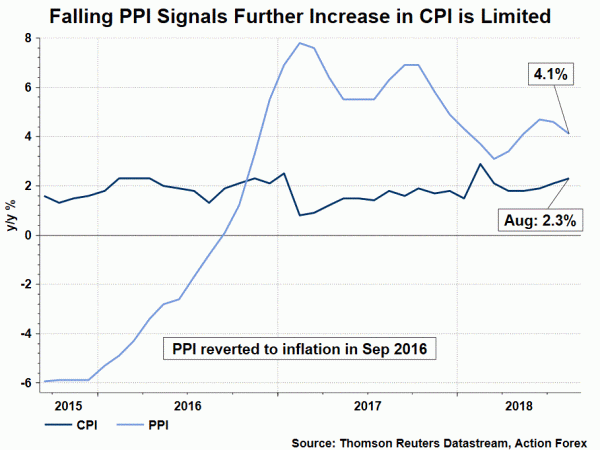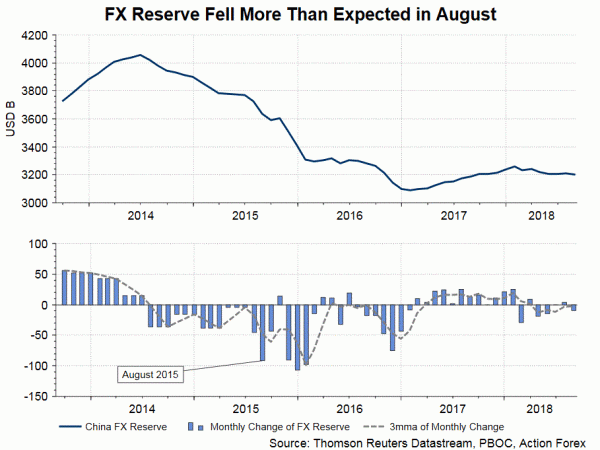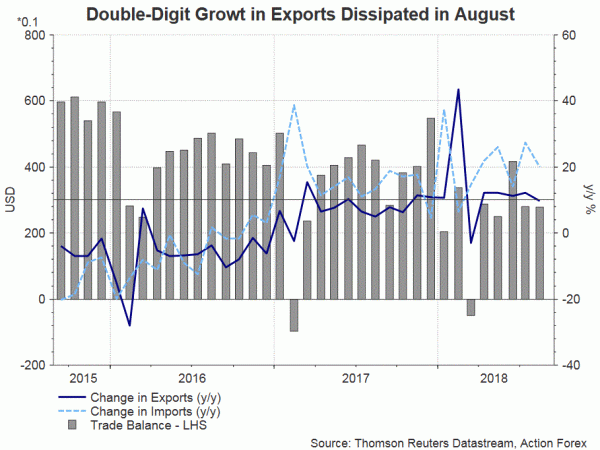China’s headline CPI rose to a 6-month high of +2.3% y/y in August, up from +2.1% a month ago. However, the increase almost entirely came from food prices which jumped to +1.7%, from +0.5% in the prior month. Taking a close look at food inflation, deflation in pork price eased to -4.9% from July’s -9.6%, while vegetable and fruit prices rose +4.3% and +5.5%, respectively. Note that the month-over-month increase in pork price was remarkable (+6.4%) as driven by African swine fever. Meanwhile, non-food inflation improved to +2.5% in August, up from +2.4% a month ago. The major drivers of non-food inflation came from housing and recreation. Core CPI edged higher, by +0.1 percentage point, to +2%.
Headline PPI eased +4.1%y/y in August, from +4.6% a month ago. This is the third consecutive slowdown which might eventually transmit to downstream price levels. This, and given the fact that CPI has remained far below the upper boundary of PBOC’s +3% target, suggests that the central bank should feel comfortable with continuing with the pro-growth monetary policy.
FX Reserve Contracted More Than Expected in August
China’s FX foreign reserve narrowed -US$8.23B to US$ 3109.72B in August. The decline was slightly more than market expectations. Weakness in major currencies against US dollar last month suggests that some of the contraction was indeed due to valuation effect. While the Chinese government has never disclosed the composition of its, it is estimated that about 65% of it was composed of US dollar. Meanwhile, about 20% is in euro, 5% in pound, 3% in Japanese yen, 2% in each of Aussie and Loonie. Using this weigh, we estimated that valuation effect took up about 75% of the decline in FX reserve, suggesting the rest could be China’s selling of foreign assets to support renminbi (Chinese Yuan). Even though China might have intervened the FX market to support its currency, the move was not significant. This indicates that capital outflow has not been severe, thanks to the imposition of 20% reserve requirement ratio (RRR) on onshore (CNY) FX forward trading as well as reintroduction of counter-cyclical factor in daily pricing of renminbi.
Effect of Trump’s Tariff Began to Show
Growth in exports slowed to +9.8% y/y in August, compared with July’s +12.2% and 2Q18’s +11.8%. Imports expanded +20% y/y, easing from July’s +27.3% but stronger than consensus of +17.7%. These resulted in a trade surplus of US$ 27.9B, broadly stable from previous months. Interestingly, trade surplus with the US rose to a new record high of US$ 31B despite Trump’s tariff. We believe this was driven by front-loading ahead of
potentially more tariff in coming months. Trump has threatened to impose 25% of tariff on an additional US$ 200B of Chinese goods. We expect implementation is likely in October/ November. China has shown no signs of backing down and is expected to retaliate.

















